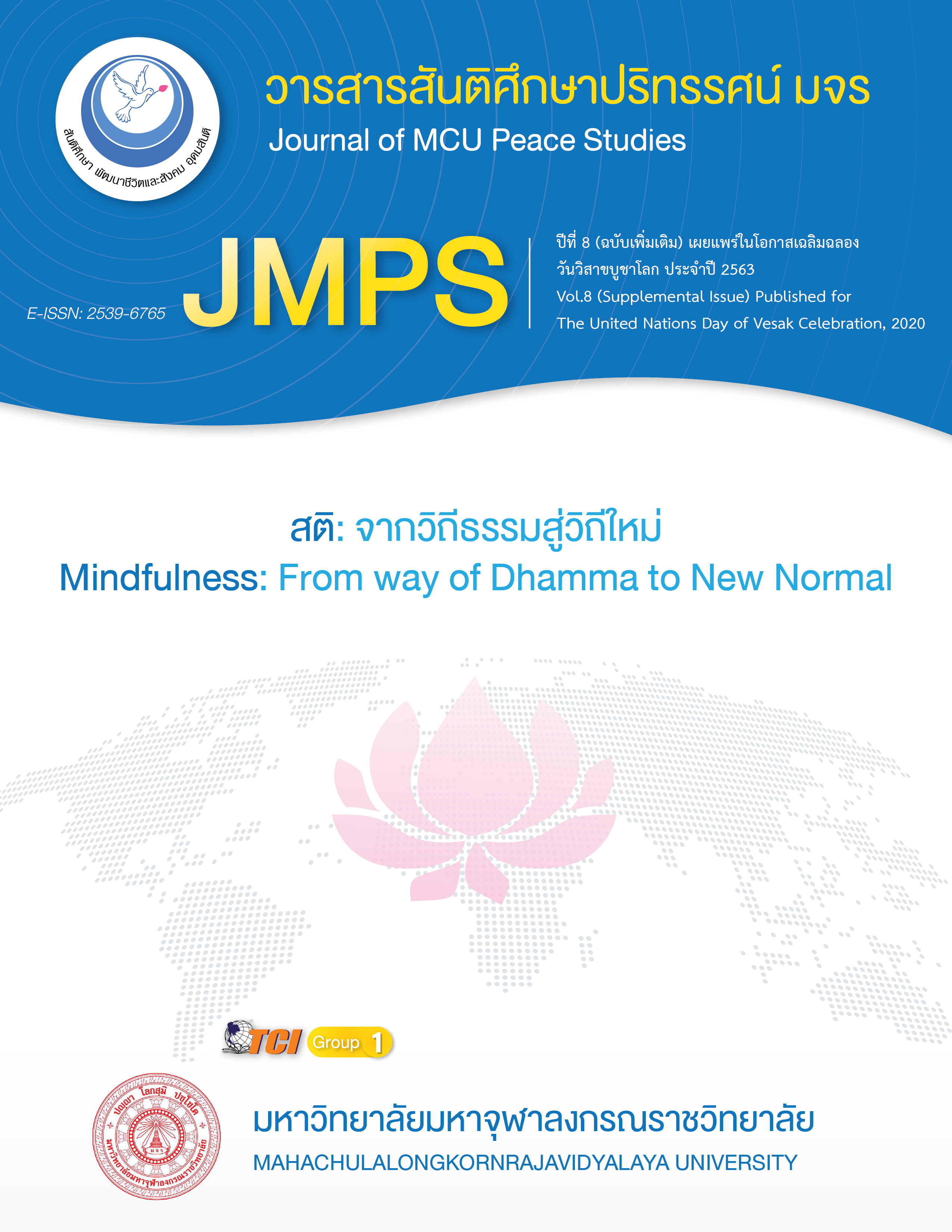ความท้าทายและสภาพปัญหาในการจัดการเรียนรู้ เรื่อง ปรากฏการณ์ดอปเพลอร์ของเสียงของครูฟิสิกส์
Main Article Content
บทคัดย่อ
บทความวิจัยนี้มีวัตถุประสงค์ เพื่อศึกษาความท้าทายและสภาพปัญหาในการจัดการเรียนรู้ เรื่อง ปรากฏการณ์ดอปเพลอร์ของเสียงของครูฟิสิกส์ รูปแบบการวิจัยเป็นการวิจัยเชิงคุณภาพ ตามแนวคิดปรากฎการณ์วิทยาของ Heidegger (1962) ผู้ให้ข้อมูลหลักเป็นครูฟิสิกส์ ที่มีประสบการณ์ ในการจัดการเรียนรู้ เรื่อง ปรากฎการณ์ดอปเพลอร์ของเสียง อย่างน้อย 3 ปี จำนวน 9 คน ใช้การเลือก แบบเฉพาะเจาะจง เครื่องมือที่ใช้ในการวิจัย คือ แบบสัมภาษณ์กึ่งโครงสร้าง วิเคราะห์ข้อมูลตามกระบวนการของ Diekelman & Allen (1989)
ผลการวิจัย พบว่า ครูทุกคนมีความรู้ความเข้าใจเกี่ยวกับ ปรากฎการณ์ดอปเพลอร์ของเสียง เป็นอย่างดี สามารถอธิบายถึงความดังกับความถี่ของเสียงได้ รวมถึงบอกถึงปัจจัยที่เกี่ยวข้องกับความถี่ของเสียงที่ผิดไปจากความเป็นจริงได้ อย่างไรก็ตามครูฟิสิกส์ยังไม่สามารถบอกถึงการนำปรากฏการณ์ ดอปเพลอร์ของเสียงมาประยุกต์ใช้ ในส่วนการจัดการเรียนรู้ ครูทุกคนมีการกำหนดวัตถุประสงค์ ของการจัดกิจกรรมการเรียนรู้ และเขียนแผนการจัดการเรียนรู้ทุกครั้ง โดยการจัดการเรียนรู้จะเน้น การบรรยาย อภิปรายถาม – ตอบ เพื่อให้นักเรียนได้ช่วยกันคิด ทั้งนี้สื่อการเรียนรู้ของครูส่วนใหญ่ (ร้อย 88.89) ใช้เอกสารประกอบการสอน ใบความรู้ ใบงาน Power point และภาพเคลื่อนไหว สาเหตุที่ครูไม่ใช้สื่อการเรียนรู้ ประเภทอุปกรณ์การทดลอง เนื่องมาจากอุปกรณ์การทดลอง มีจำนวนไม่เพียงพอ และสำหรับการวัด และประเมินผล ครูทำการวัด และประเมินผลของนักเรียน โดยให้นักเรียนตอบคำถามท้ายคาบเรียน และการสอบโดยใช้ ข้อสอบปรนัย ที่เน้นการคำนวณ
Article Details
ทัศนะและความคิดเห็นที่ปรากฏในบทความในวารสาร ถือเป็นความรับผิดชอบของผู้เขียนบทความนั้น และไม่ถือเป็นทัศนะและความรับผิดชอบของกองบรรณาธิการ ยินยอมว่าบทความเป็นลิขสิทธิ์ของวารสาร
เอกสารอ้างอิง
Arphonpisan, P. (2005). The Development of an Experimental Set in Motion on Magnetic Field for the Forth Key Stage Students in Changwat Nakhonpathom. Thesis Master of Education. Srinakharinwirot University.
Banks, F., Leach, J. & Moon, B. (2005). New Understandings of Teachers’ Pedagogic Knowledge. The Curriculum Journal, 16(3), 331-340.
Chaowakiratipong, N. (2017). Writing a Learning Management Plan for Teaching and Learning in Science. Veridian E-Journal of Silpakorn University, 10 (1), 11-127.
Chi, M.T.H. Feltovich, P.J. & Glasner, R. (1981). Categorization and Representation of Physics Problem by Expert and Novices. Cognitive Science, 5(2), 121-152.
Comsingnog, T. (2007). Development of the Computer Game "Save Energy: Save the Earth" for the Upper Primary Level (Grade 4-6) Students. Thesis Master of Education. Mahidol University.
Constant, F. Woodbridge. (1967). Fundamental Principles of Physics. Massachusetts: Addisson Wesley Publishing Company.
Cox, A.J & Junkin, W.F. ( 2 0 0 2 ) . Enhanced Student Learning in the Introductory Physics Laboratory. Journal of Physics Education, 37(1), 1-8.
Diekelmann N. & Allen D. (1989). A Hermeneutic Analysis of the NLN’s Criteria for the Appraisal of the Baccalaureate Programs. New York: National League for Nursing.
Docktor, J.L. (2002). Physics Problem Solving. Minnesota: University of Minnesota.
Dutjathat, T. (2011). Developing Experimental Set on Torque and Moment of Inertia for Improving Learning Achievement in Physics. Thesis Master of Science. Ubonratchathani University.
Halloun & Hestenes. (1985). Common Sense Concepts About Motion. American Journal of Physics, 53(11), 1056-1065.
Heidegger M. (1962). Being and Time (MacQuarrie J. & Robinson E. Trans). New York: Harper & Row. Retrieved December 25, 2019, from http://www.newonetresult.niets.or.th/AnnouncementWeb/PDF/SummaryONETM6_2559.pdf.
Heller, P. & Reif, F. (1982). Prescribing Effective Human Problem-solving Processes: Problem Descriptions in Physics. Cognition and Instruction, 1(2), 177-216.
Ketthat, L. (1998). Concepts of Science and Technology Directions and Policies of Thailand. Academic Journal of Department of Academic Affairs, 1(5), 2-15.
Khim, K.C. (1978). Integration of Secondary Level Physics and Technology Education. Physics Curriculum Development in Asia 1978. Report of Regional Seminar Penang Malaysia.
Kiatkamonchai, S. & Tukrakai, P. (2005). Physics Demonstration for Teaching General Physics 1. Bangkok: Chulalongkorn University.
Kornsai, R. (2007). Development of the Computer – Insisted Instruction in Physics 1 Concerning Force Mass and Law of Motion for the Fourth Year Secondary Level. Thesis Master of Education. Sakonnakhon Rajabhat University.
Linder, C. & Erickson, G. (1989). A Study of Tertiary Physics Students' Conceptualization of Sound. International Journal of Science Education,11(5), 491-501.
Linder, C.J. (1993). University Physics Students’ Conceptualizations of Factors Affecting the Speed of Sound Propagation. International Journal of Science Education, 15(6), 655-662.
Mosabala, M.S. (2014) . The Teaching of Doppler Effect at Grade 1 2- Teacher’s Content Knowledge. Mediterranean Journal of Social Sciences, 14(5), 207-213.
National Institute of Educational Testing Service. (2017). Summary Table of the Basic National Educational Test (O-NET) Matthayom Suksa 6, Academic Year 2016. Retrieved October, 10 2017, from np.
Roth, W.M. (1994). Experimenting in a Constructivist High School Physics Laboratory. Journal of Research in Science Teaching, 31(2), 197-223.
Sangpradit, T. (2015) . Student Alternative Conceptions in Physics. Journal of Education Naresuan University, 17(4), 202-209.
Sirisarn, B. (2004). A Production of VCD Instructional Media on Doppler Effect in Physics for Matthayom Suksa V Students. An Independent Study Report. Khon Kaen University.
Somsak, A. (2001). User of Educational Innovations for Science Subjects in Chiang Mai Secondary Schools. Thesis Master of Education. Chiang Mai University.
Sripha, K. (2011). Near-Death Experience of Terminally Ill Patients: A Phenomenological Study. Ph.D. Dissertation. Srinakharinwirot University.
Sukhonkhet, T. & Thamsri, W. (2014). The Application of Science Knowledge in the Daily Life Using Knowledge Inquiry Activity. SDU Research Journal Sciences and Technology, 10(2), 181-196.
Susheva, S. (1995). Development of Diagnostic Method for dDtecting Mathematical Misconception. Ph.D. Dissertation. Chulalongkorn University.
Tadang, N. et al. ( 2 0 1 4 ) . Instructional Media in Basic Education. Nonthaburi: Sukhothai Thammathirat Open University.
Thai Physics Association. (2008). Time Changed ... Your Physics Score Changed ... Who Did this? (Physics learning results of the first year university level during changing the entrance examination system). Thai Journal of Physics, 25(3), 19-24.
The Institute for the Promotion of Teaching Science and Technology. (2012). Evaluation of Scientific Evaluation. Bangkok: Institute for the Promotion of Teaching Science and Technology.
The Institute for the Promotion of Teaching Science and Technology. (2017).Teacher’s Manual Method for Additional Subjects in Physics Grade 5 Volume 3. The Institute for the Promotion of Teaching Science and Technology.
Young, H.D. & Freedman, R.A. (2014). University Physics with Modern Physics 14th Edition. The United States of America. Pearson Education, Inc.


